Ming He
Decoding Recommendation Behaviors of In-Context Learning LLMs Through Gradient Descent
Apr 06, 2025Abstract:Recently, there has been a growing trend in utilizing large language models (LLMs) for recommender systems, referred to as LLMRec. A notable approach within this trend is not to fine-tune these models directly but instead to leverage In-Context Learning (ICL) methods tailored for LLMRec, denoted as LLM-ICL Rec. Many contemporary techniques focus on harnessing ICL content to enhance LLMRec performance. However, optimizing LLMRec with ICL content presents unresolved challenges. Specifically, two key issues stand out: (1) the limited understanding of why using a few demonstrations without model fine-tuning can lead to better performance compared to zero-shot recommendations. (2) the lack of evaluation metrics for demonstrations in LLM-ICL Rec and the absence of the theoretical analysis and practical design for optimizing the generation of ICL content for recommendation contexts. To address these two main issues, we propose a theoretical model, the LLM-ICL Recommendation Equivalent Gradient Descent model (LRGD) in this paper, which connects recommendation generation with gradient descent dynamics. We demonstrate that the ICL inference process in LLM aligns with the training procedure of its dual model, producing token predictions equivalent to the dual model's testing outputs. Building on these theoretical insights, we propose an evaluation metric for assessing demonstration quality. We integrate perturbations and regularizations in LRGD to enhance the robustness of the recommender system. To further improve demonstration effectiveness, prevent performance collapse, and ensure long-term adaptability, we also propose a two-stage optimization process in practice. Extensive experiments and detailed analysis on three Amazon datasets validate the theoretical equivalence and support the effectiveness of our theoretical analysis and practical module design.
MAPS: Motivation-Aware Personalized Search via LLM-Driven Consultation Alignment
Mar 05, 2025Abstract:Personalized product search aims to retrieve and rank items that match users' preferences and search intent. Despite their effectiveness, existing approaches typically assume that users' query fully captures their real motivation. However, our analysis of a real-world e-commerce platform reveals that users often engage in relevant consultations before searching, indicating they refine intents through consultations based on motivation and need. The implied motivation in consultations is a key enhancing factor for personalized search. This unexplored area comes with new challenges including aligning contextual motivations with concise queries, bridging the category-text gap, and filtering noise within sequence history. To address these, we propose a Motivation-Aware Personalized Search (MAPS) method. It embeds queries and consultations into a unified semantic space via LLMs, utilizes a Mixture of Attention Experts (MoAE) to prioritize critical semantics, and introduces dual alignment: (1) contrastive learning aligns consultations, reviews, and product features; (2) bidirectional attention integrates motivation-aware embeddings with user preferences. Extensive experiments on real and synthetic data show MAPS outperforms existing methods in both retrieval and ranking tasks.
Towards Heisenberg limit without critical slowing down via quantum reinforcement learning
Mar 04, 2025Abstract:Critical ground states of quantum many-body systems have emerged as vital resources for quantum-enhanced sensing. Traditional methods to prepare these states often rely on adiabatic evolution, which may diminish the quantum sensing advantage. In this work, we propose a quantum reinforcement learning (QRL)-enhanced critical sensing protocol for quantum many-body systems with exotic phase diagrams. Starting from product states and utilizing QRL-discovered gate sequences, we explore sensing accuracy in the presence of unknown external magnetic fields, covering both local and global regimes. Our results demonstrate that QRL-learned sequences reach the finite quantum speed limit and generalize effectively across systems of arbitrary size, ensuring accuracy regardless of preparation time. This method can robustly achieve Heisenberg and super-Heisenberg limits, even in noisy environments with practical Pauli measurements. Our study highlights the efficacy of QRL in enabling precise quantum state preparation, thereby advancing scalable, high-accuracy quantum critical sensing.
Instruct-of-Reflection: Enhancing Large Language Models Iterative Reflection Capabilities via Dynamic-Meta Instruction
Mar 02, 2025Abstract:Self-reflection for Large Language Models (LLMs) has gained significant attention. Existing approaches involve models iterating and improving their previous responses based on LLMs' internal reflection ability or external feedback. However, recent research has raised doubts about whether intrinsic self-correction without external feedback may even degrade performance. Based on our empirical evidence, we find that current static reflection methods may lead to redundant, drift, and stubborn issues. To mitigate this, we introduce Instruct-of-Reflection (IoRT), a novel and general reflection framework that leverages dynamic-meta instruction to enhance the iterative reflection capability of LLMs. Specifically, we propose the instructor driven by the meta-thoughts and self-consistency classifier, generates various instructions, including refresh, stop, and select, to guide the next reflection iteration. Our experiments demonstrate that IoRT achieves an average improvement of 10.1% over established baselines in mathematical and commonsense reasoning tasks, highlighting its efficacy and applicability.
LinRec: Linear Attention Mechanism for Long-term Sequential Recommender Systems
Nov 03, 2024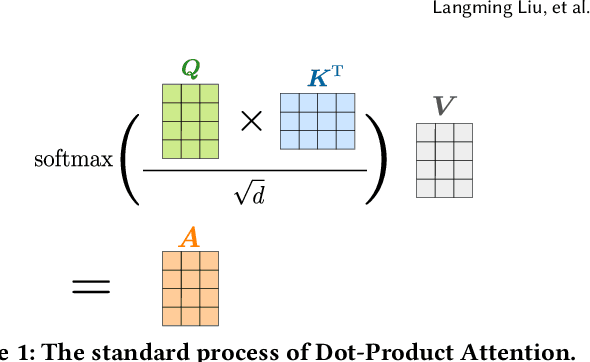

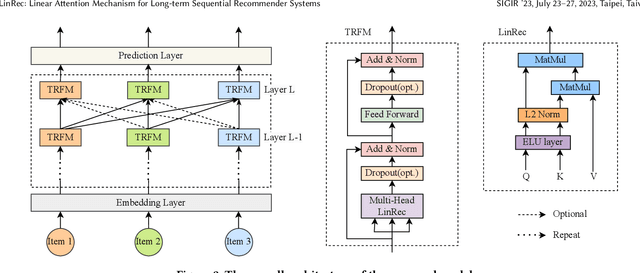
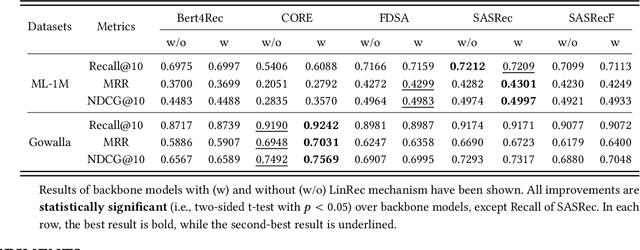
Abstract:Transformer models have achieved remarkable success in sequential recommender systems (SRSs). However, computing the attention matrix in traditional dot-product attention mechanisms results in a quadratic complexity with sequence lengths, leading to high computational costs for long-term sequential recommendation. Motivated by the above observation, we propose a novel L2-Normalized Linear Attention for the Transformer-based Sequential Recommender Systems (LinRec), which theoretically improves efficiency while preserving the learning capabilities of the traditional dot-product attention. Specifically, by thoroughly examining the equivalence conditions of efficient attention mechanisms, we show that LinRec possesses linear complexity while preserving the property of attention mechanisms. In addition, we reveal its latent efficiency properties by interpreting the proposed LinRec mechanism through a statistical lens. Extensive experiments are conducted based on two public benchmark datasets, demonstrating that the combination of LinRec and Transformer models achieves comparable or even superior performance than state-of-the-art Transformer-based SRS models while significantly improving time and memory efficiency.
Collaborative Knowledge Fusion: A Novel Approach for Multi-task Recommender Systems via LLMs
Oct 28, 2024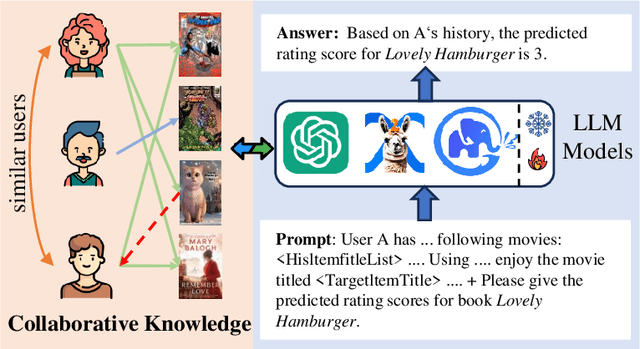
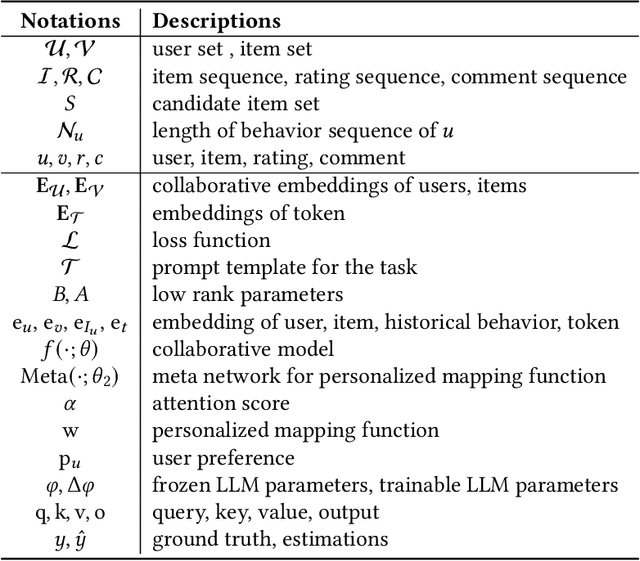


Abstract:Owing to the impressive general intelligence of large language models (LLMs), there has been a growing trend to integrate them into recommender systems to gain a more profound insight into human interests and intentions. Existing LLMs-based recommender systems primarily leverage item attributes and user interaction histories in textual format, improving the single task like rating prediction or explainable recommendation. Nevertheless, these approaches overlook the crucial contribution of traditional collaborative signals in discerning users' profound intentions and disregard the interrelatedness among tasks. To address these limitations, we introduce a novel framework known as CKF, specifically developed to boost multi-task recommendations via personalized collaborative knowledge fusion into LLMs. Specifically, our method synergizes traditional collaborative filtering models to produce collaborative embeddings, subsequently employing the meta-network to construct personalized mapping bridges tailored for each user. Upon mapped, the embeddings are incorporated into meticulously designed prompt templates and then fed into an advanced LLM to represent user interests. To investigate the intrinsic relationship among diverse recommendation tasks, we develop Multi-Lora, a new parameter-efficient approach for multi-task optimization, adept at distinctly segregating task-shared and task-specific information. This method forges a connection between LLMs and recommendation scenarios, while simultaneously enriching the supervisory signal through mutual knowledge transfer among various tasks. Extensive experiments and in-depth robustness analyses across four common recommendation tasks on four large public data sets substantiate the effectiveness and superiority of our framework.
Generating Model Parameters for Controlling: Parameter Diffusion for Controllable Multi-Task Recommendation
Oct 14, 2024



Abstract:Commercial recommender systems face the challenge that task requirements from platforms or users often change dynamically (e.g., varying preferences for accuracy or diversity). Ideally, the model should be re-trained after resetting a new objective function, adapting to these changes in task requirements. However, in practice, the high computational costs associated with retraining make this process impractical for models already deployed to online environments. This raises a new challenging problem: how to efficiently adapt the learning model to different task requirements by controlling model parameters after deployment, without the need for retraining. To address this issue, we propose a novel controllable learning approach via Parameter Diffusion for controllable multi-task Recommendation (PaDiRec), which allows the customization and adaptation of recommendation model parameters to new task requirements without retraining. Specifically, we first obtain the optimized model parameters through adapter tunning based on the feasible task requirements. Then, we utilize the diffusion model as a parameter generator, employing classifier-free guidance in conditional training to learn the distribution of optimized model parameters under various task requirements. Finally, the diffusion model is applied to effectively generate model parameters in a test-time adaptation manner given task requirements. As a model-agnostic approach, PaDiRec can leverage existing recommendation models as backbones to enhance their controllability. Extensive experiments on public datasets and a dataset from a commercial app, indicate that PaDiRec can effectively enhance controllability through efficient model parameter generation. The code is released at https://anonymous.4open.science/r/PaDiRec-DD13.
Enhancing Sequential Recommendations through Multi-Perspective Reflections and Iteration
Sep 10, 2024



Abstract:Sequence recommendation (SeqRec) aims to predict the next item a user will interact with by understanding user intentions and leveraging collaborative filtering information. Large language models (LLMs) have shown great promise in recommendation tasks through prompt-based, fixed reflection libraries, and fine-tuning techniques. However, these methods face challenges, including lack of supervision, inability to optimize reflection sources, inflexibility to diverse user needs, and high computational costs. Despite promising results, current studies primarily focus on reflections of users' explicit preferences (e.g., item titles) while neglecting implicit preferences (e.g., brands) and collaborative filtering information. This oversight hinders the capture of preference shifts and dynamic user behaviors. Additionally, existing approaches lack mechanisms for reflection evaluation and iteration, often leading to suboptimal recommendations. To address these issues, we propose the Mixture of REflectors (MoRE) framework, designed to model and learn dynamic user preferences in SeqRec. Specifically, MoRE introduces three reflectors for generating LLM-based reflections on explicit preferences, implicit preferences, and collaborative signals. Each reflector incorporates a self-improving strategy, termed refining-and-iteration, to evaluate and iteratively update reflections. Furthermore, a meta-reflector employs a contextual bandit algorithm to select the most suitable expert and corresponding reflections for each user's recommendation, effectively capturing dynamic preferences. Extensive experiments on three real-world datasets demonstrate that MoRE consistently outperforms state-of-the-art methods, requiring less training time and GPU memory compared to other LLM-based approaches in SeqRec.
MobileExperts: A Dynamic Tool-Enabled Agent Team in Mobile Devices
Jul 04, 2024



Abstract:The attainment of autonomous operations in mobile computing devices has consistently been a goal of human pursuit. With the development of Large Language Models (LLMs) and Visual Language Models (VLMs), this aspiration is progressively turning into reality. While contemporary research has explored automation of simple tasks on mobile devices via VLMs, there remains significant room for improvement in handling complex tasks and reducing high reasoning costs. In this paper, we introduce MobileExperts, which for the first time introduces tool formulation and multi-agent collaboration to address the aforementioned challenges. More specifically, MobileExperts dynamically assembles teams based on the alignment of agent portraits with the human requirements. Following this, each agent embarks on an independent exploration phase, formulating its tools to evolve into an expert. Lastly, we develop a dual-layer planning mechanism to establish coordinate collaboration among experts. To validate our effectiveness, we design a new benchmark of hierarchical intelligence levels, offering insights into algorithm's capability to address tasks across a spectrum of complexity. Experimental results demonstrate that MobileExperts performs better on all intelligence levels and achieves ~ 22% reduction in reasoning costs, thus verifying the superiority of our design.
Performative Debias with Fair-exposure Optimization Driven by Strategic Agents in Recommender Systems
Jun 25, 2024Abstract:Data bias, e.g., popularity impairs the dynamics of two-sided markets within recommender systems. This overshadows the less visible but potentially intriguing long-tail items that could capture user interest. Despite the abundance of research surrounding this issue, it still poses challenges and remains a hot topic in academic circles. Along this line, in this paper, we developed a re-ranking approach in dynamic settings with fair-exposure optimization driven by strategic agents. Designed for the producer side, the execution of agents assumes content creators can modify item features based on strategic incentives to maximize their exposure. This iterative process entails an end-to-end optimization, employing differentiable ranking operators that simultaneously target accuracy and fairness. Joint objectives ensure the performance of recommendations while enhancing the visibility of tail items. We also leveraged the performativity nature of predictions to illustrate how strategic learning influences content creators to shift towards fairness efficiently, thereby incentivizing features of tail items. Through comprehensive experiments on both public and industrial datasets, we have substantiated the effectiveness and dominance of the proposed method especially on unveiling the potential of tail items.
 Add to Chrome
Add to Chrome Add to Firefox
Add to Firefox Add to Edge
Add to Edge